Home Medical Equipment Market Size
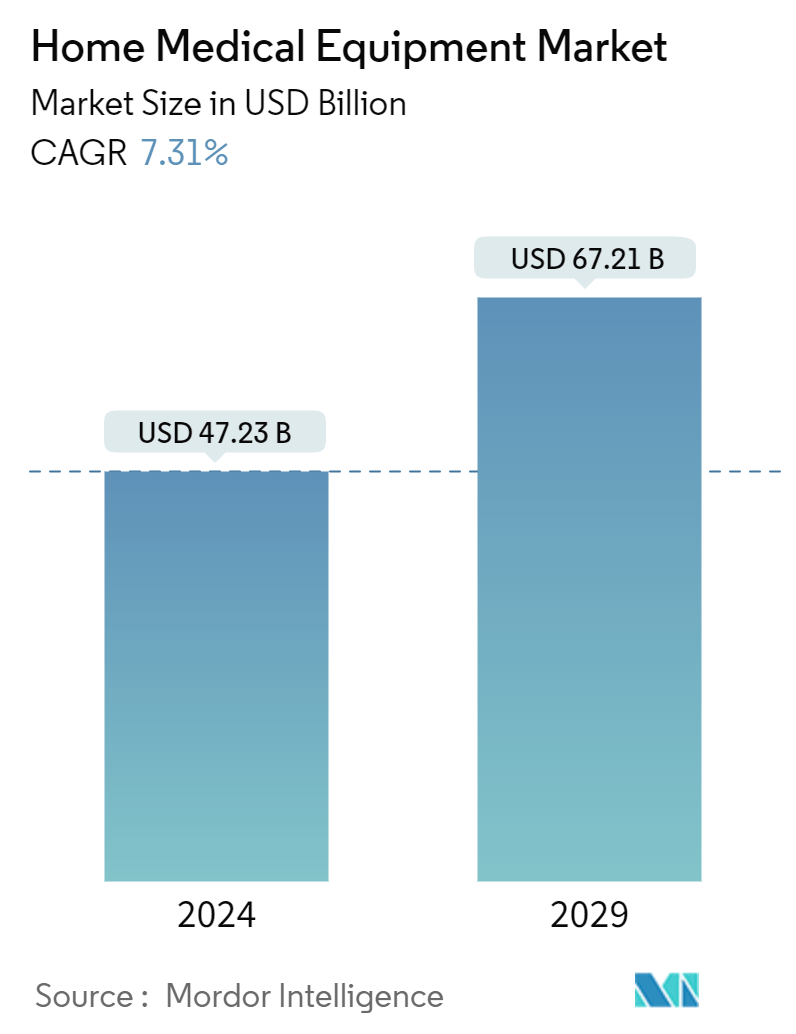
| Study Period | 2019 - 2029 |
| Market Size (2024) | USD 47.23 Billion |
| Market Size (2029) | USD 67.21 Billion |
| CAGR (2024 - 2029) | 7.31 % |
| Fastest Growing Market | Asia-Pacific |
| Largest Market | North America |
| Market Concentration | Medium |
Major Players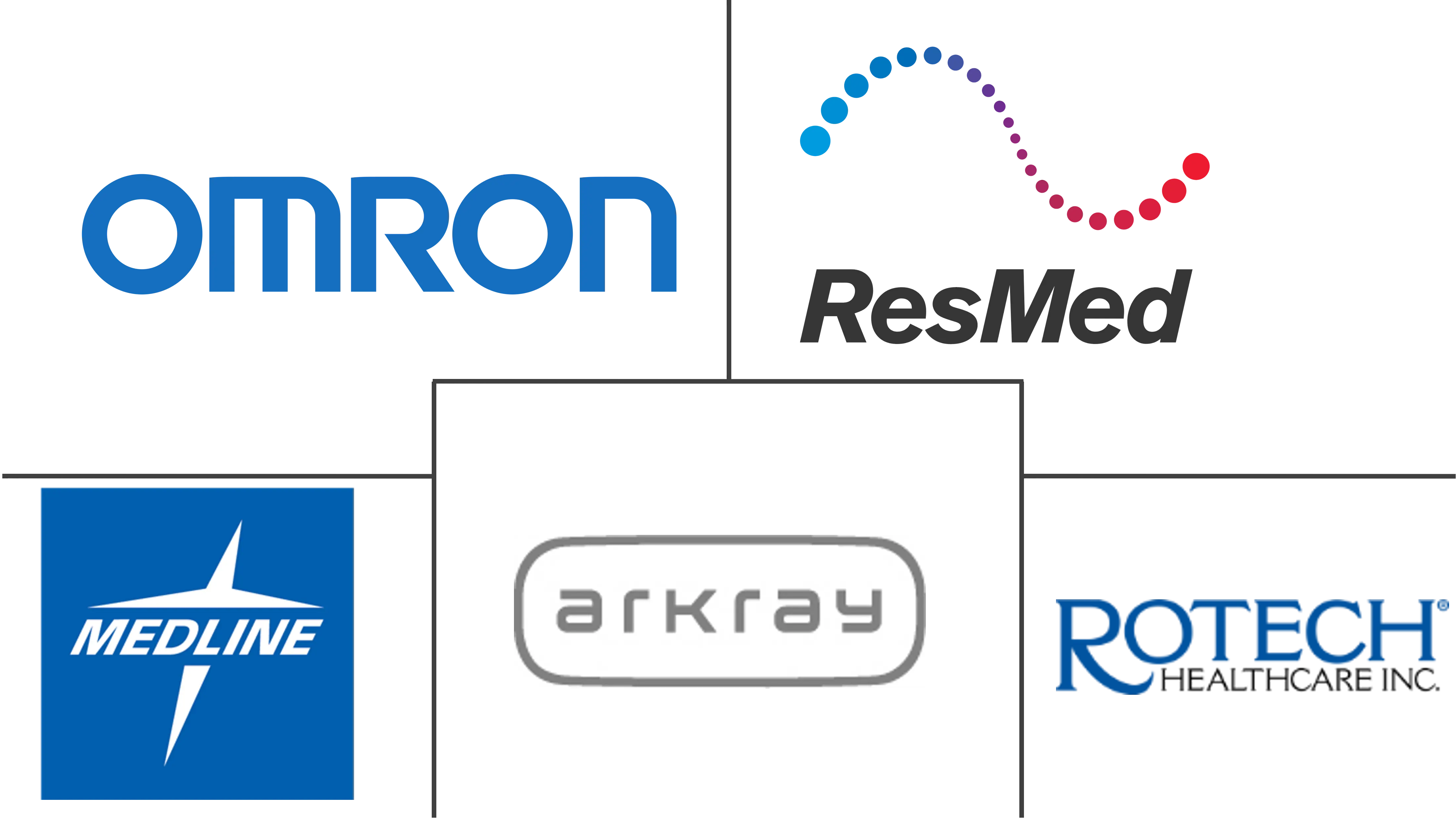
*Disclaimer: Major Players sorted in no particular order |
Home Medical Equipment Market Analysis
The Home Medical Equipment Market size is estimated at USD 47.23 billion in 2024, and is expected to reach USD 67.21 billion by 2029, growing at a CAGR of 7.31% during the forecast period (2024-2029).
The COVID-19 pandemic has positively impacted the home medical equipment market owing to the increased demand for home medical equipment such as life-supporting and life-sustaining devices during the pandemic. However, the disruption of conventional manufacturing, and supply chain during the COVID-19 pandemic led to shortages in various medical supplies and equipment. To overcome the shortages of medical supplies the government framed several measures to closely monitor the reason for the disruption as well as to increase the procurement of several medical equipments. Also, the demand for respiratory devices such as ventilators, oxygen concentrators, and other have increased which urged companies to increase their production as well as launch different products during the pandemic. For instance, in April 2021, Philips Respironics launched a new and improved auto CPAP machine named DreamStation 2 CPAP in the United States. Hence, the COVID-19 pandemic has significantly impacted the market during the initial phases of the pandemic, but with resumed services, the demand for home medical equipment has increased and the market has witnessed significant growth.
Factors such as the increasing prevalence of chronic disorders and the rising geriatric population as well as the growing adoption of self-health management are major factors driving the market growth.
The high burden of chronic diseases is the key factor driving the demand for the home medical equipment market. For instance, according to 2022 statistics published by the International Diabetes Federation, about 537 million people were living with diabetes in 2021, globally, and this number is projected to reach 643 million and 784 million by 2030 and 2045, respectively. The high blood sugar caused by diabetes can damage the nerves that control the heart and blood vessels, leading to a variety of cardiovascular diseases like coronary artery disease and stroke, which can narrow the arteries. This is anticipated to rise the need for monitoring glucose levels, blood pressure, and other activities, hence bolstering the demand for medical equipment such as monitoring devices that can provide data to physicians to help them more effectively evaluate patient conditions and react quickly to any abnormalities. Also, as per the German Heart Surgery 2021 report, about 92,838 heart surgeries were performed in Germany, including 36,714 isolated heart valve procedures, 27,947 isolated coronary artery bypass grafting procedures, and 329 isolated heart transplantations in 2021. Thus, the high number of patients with cardiac surgeries requires regular and ongoing monitoring, which increases the demand for patient monitoring equipment, thereby propelling the market growth.
Additionally, the utilization and adoption of self-health management has increased owing to the large proportion of the population suffering from chronic conditions, worldwide, and struggles to manage the symptoms on their own. This has further increased the focus of organizations and companies to launch self-health management programs and applications, respectively. For instance, in March 2022, MFine launched a new feature of heart rate monitoring on its phone-based application called MFine-Pulse and this function uses a camera and flash of the smartphone to detect blood volume changes. Also, in March 2022, Alinche Lifesciences launched a healthcare application for chronic kidney disease (CKD) patients that offers a wide range of information like kidney health, exercises, and daily health routine, in India.
Furthermore, the increasing company activities in adopting various key strategies such as collaborations, partnerships, and new product launches are also expected to increase the availability of novel equipment in the market. For instance, in October 2022, DexCom, Inc launched Dexcom G7 Continuous Glucose Monitoring (CGM) System, for people with diabetes aged two years and older in Germany. Also, in July 2022, OMRON Healthcare launched a portable oxygen concentrator to help home care workers manage the therapy and daily needs of patients with COPD and respiratory diseases.
Therefore, owing to the aforementioned factors, such as the high burden of chronic diseases among the population and the increasing adoption of self-health management, the studied market is expected to grow over the forecast period. However, the high cost associated with home medical equipment and stringent regulations is likely to hinder the growth of the home medical equipment market over the forecast period.
Home Medical Equipment Market Trends
Respiratory Therapy Equipment Segment is Expected to Witness Significant Growth Over the Forecast Period
The respiratory therapy equipment segment is expected to witness significant growth in the home medical equipment market over the forecast period owing to the factors such as the increasing prevalence of respiratory disorders, emerging advanced technology, and rising company activities.
The prevalence of respiratory disorders, such as COPD, tuberculosis, asthma, and sleep apnea is increasing globally which is expected to fuel the demand for respiratory equipment. For instance, as per the data published by CDC in December 2022, about 4.6% of individuals had received a COPD, emphysema, or chronic bronchitis diagnosis at some point in 2021. Similarly, according to a study published in PLOS One, in January 2021, about 2.6 million people were suffering from COPD, in 2021, and the number is expected to rise to 2.8 million by 2025.
Additionally, the rising introduction of technologically advanced products in the market is also anticipated to fuel the segment's growth. For instance, as per an article published in Respiratory Care, in October 2021, portable oxygen concentrators (POCs) are efficient at supplying necessary oxygen in several patient settings. Also, from the same source, it has been observed that the maximum oxygen reading was obtained at 30 breaths per minute (27.89%) by the CAIRE FreeStyle Comfort with AutoSat, and the highest readings at 15 and 40 breaths per minute, (31.56% and 26.13%) respectively, by the CAIRE FreeStyle Comfort without AutoSat. Thus, the high performance of POCs is expected to increase its demand, which in turn is anticipated to accelerate the segment growth.
Furthermore, the increasing focus of the companies on developing technologically advanced products increases the availability of novel respiratory equipment in the market, thereby contributing to segment growth. For instance, in May 2022, Max ventilator launched multifunctional noninvasive ventilators with inbuild oxygen therapy and humidifier, in India. Also, in February 2022, Vitalograph received United States FDA approval for an Alpha spirometer, a next-generation lightweight and durable tool with an integrated printer used for accurate respiratory diagnosis of both adults and pediatrics.
Therefore, owing to the aforementioned factors, such as the high burden of respiratory diseases, rising new product launches, and growing adoption of technologically advanced products, the studied segment is anticipated to grow over the forecast period.
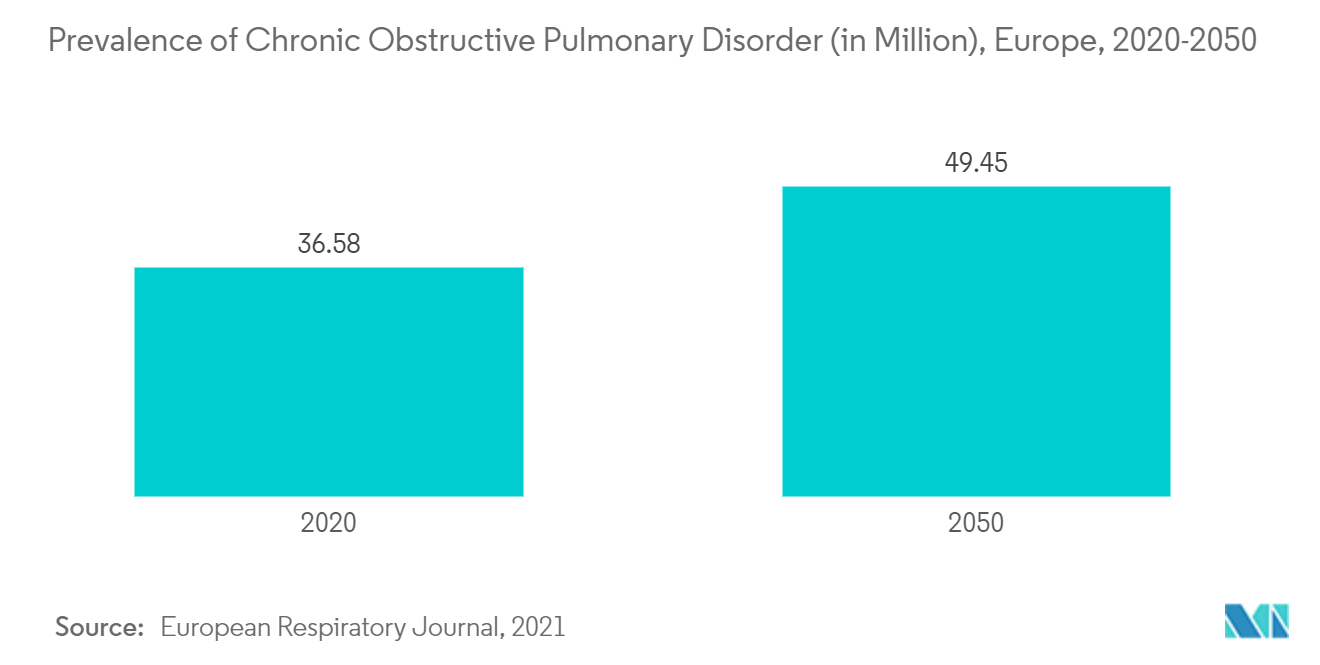
North America is Expected to Have the Significant Market Share Over the Forecast Period
North America is expected to hold a significant share of the market owing to the factors such as the rising burden of chronic diseases and their associated risk factors, the presence of well-established healthcare infrastructure along with high healthcare spending, as well as the increasing company activities in the region.
The increasing incidence and prevalence of chronic diseases among the population is the key factor driving the market growth. For instance, as per data updated by the government of Canada in July 2021, an overall 6.3 million population of aged 65 or more were living with chronic conditions in 2021 in Canada. This raises the demand for medical equipment, such as monitoring devices, telemedicine patient monitoring, and others, which helps in regular monitoring of the patients, which in turn is anticipated to fuel market growth.
Additionally, the rising government initiatives to promote self-management programs in the region are also expected to fuel market growth. For instance, in November 2022, the government of Canada funded over USD 5 million to enhance support for people living with chronic pain and to expand the Pain Canada Network. With this network, the people experiencing pain, mental health issues, substance use harm, and other forms of social and economic marginalization gain access to a ten-week in-person self-management program. Also, in January 2022, the Lupus Foundation of America (LFA) launched Strategies to Embrace Living with Lupus Fearlessly (SELF), a new online self-management program designed to aid lupus sufferers in developing and improving their skills in the four areas of managing symptoms, stress, drugs, and working with their healthcare team. Hence, this is likely to contribute to the market growth over the forecast period.
Moreover, the increasing number of new product launches in the region is also expected to fuel market growth. For instance, in August 2022, CardiAI Inc., launched a new 24-hour Ambulatory Blood Pressure monitoring system, BPAro, a compact, portable, self-monitoring blood pressure device that uses Bluetooth for wireless data collection. Also, in March 2022, Nipro Medical Corporation (Nipro) launched SURDIAL DX Hemodialysis System in the United States. Also, in December 2021, Medtronic Canada signed an exclusive corporate agreement with Cloud DX to offer virtual and remote patient monitoring (RPM) solutions across Canada.
Therefore, owing to the aforementioned factors, such as the high burden of chronic diseases, growing government initiatives, and new product launches, the studied market is expected to grow over the forecast period.
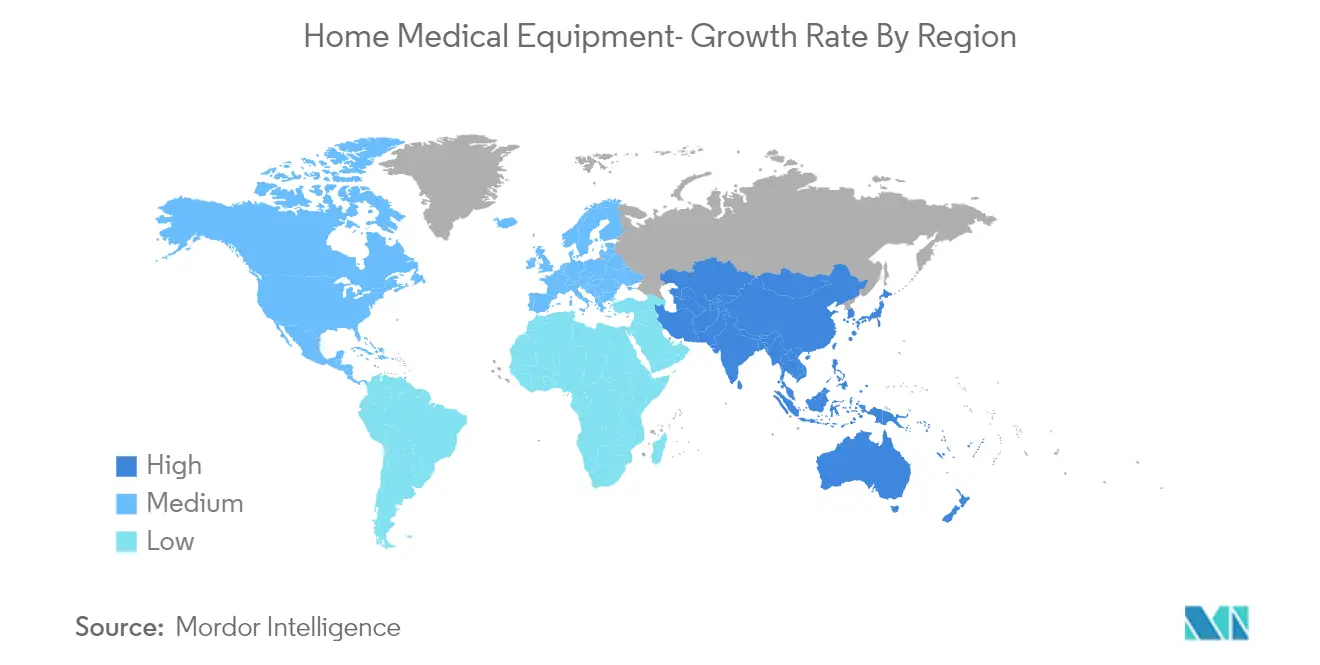
Home Medical Equipment Industry Overview
The home medical equipment market is fragmented owing to the presence of a large number of key players. The companies are adopting various key business strategies such as collaborations, partnerships, agreements, and new product launches to withhold their position in the market. Some of the key companies in the market are Rotech Healthcare Inc., Medline Industries, Inc., Omron Healthcare, Inc., Resmed Corporation, ARKRAY, Inc., and Rotech Healthcare Inc. among others.
Home Medical Equipment Market Leaders
-
Rotech Healthcare Inc.
-
ARKRAY, INC.
-
ResMed
-
Medline Industries, Inc.
-
Omron Healthcare, Inc.
*Disclaimer: Major Players sorted in no particular order
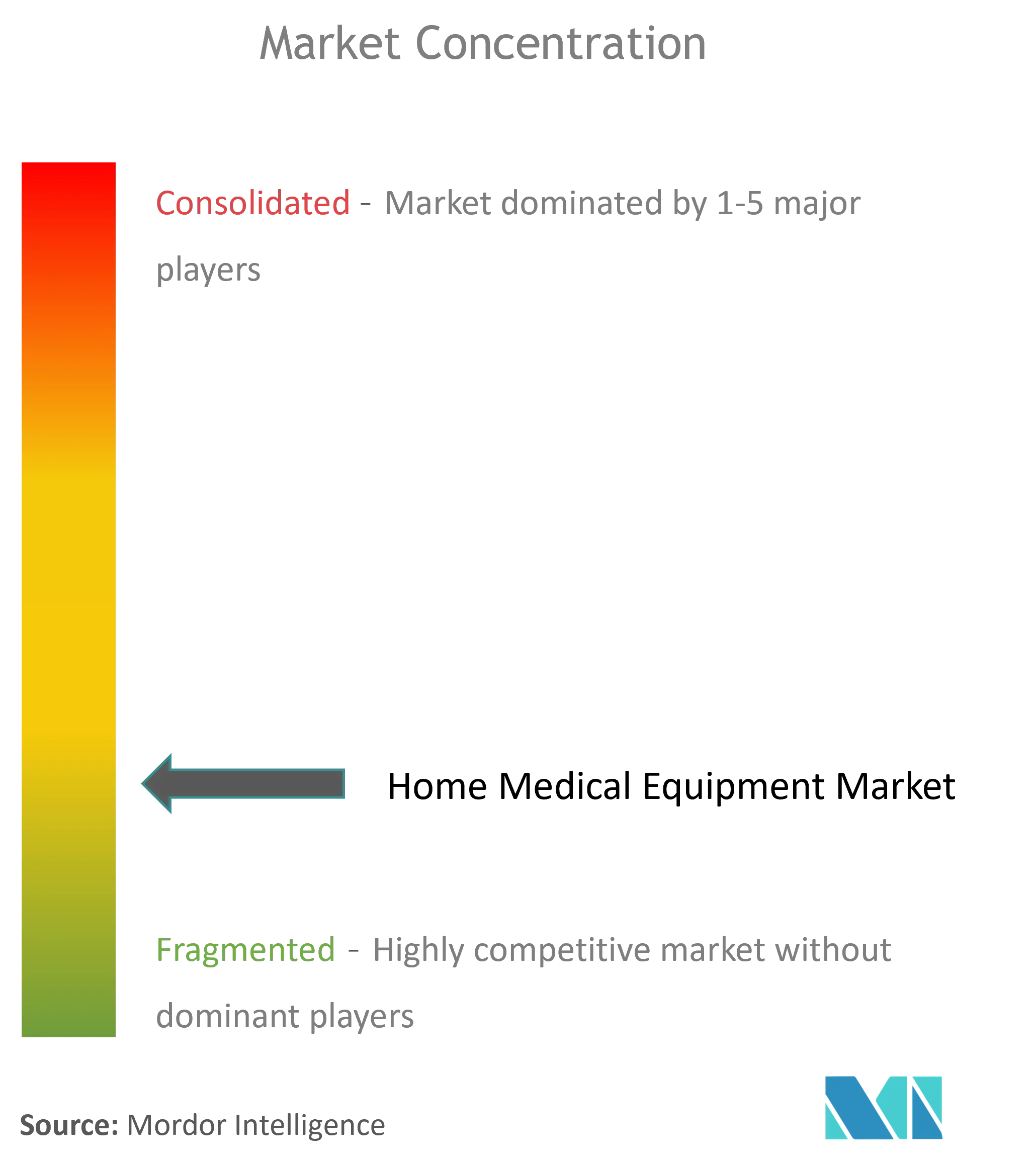
Home Medical Equipment Market News
- In December 2022, Mindray launched a new wearable monitoring solution, 'mWear System' to continually monitor patient conditions and provide patient-centric care. The system combines complete wireless interconnection with streamlined workflows, accurate multi-parameter monitoring, and seamless integration for home-hospital settings.
- In July 2022, B. Braun Medical Inc. launched a new Introcan Safety 2 IV Catheter, with one-time blood control for making IV access safer for the clinician by reducing the risk of needlestick injuries and their exposure to blood.
Home Medical Equipment Market Report - Table of Contents
1. INTRODUCTION
1.1 Study Assumptions and Market Definition
1.2 Scope of the Study
2. RESEARCH METHODOLOGY
3. EXECUTIVE SUMMARY
4. MARKET DYNAMICS
4.1 Market Overview
4.2 Market Drivers
4.2.1 Increasing Prevalence of Chronic Disorders
4.2.2 Growing Geriatric Population
4.2.3 Rising Adoption of Self-Health Management
4.3 Market Restraints
4.3.1 High Cost Associated with Home Medical Equipment
4.3.2 Stringent Regulations
4.4 Porter's Five Force Analysis
4.4.1 Threat of New Entrants
4.4.2 Bargaining Power of Buyers/Consumers
4.4.3 Bargaining Power of Suppliers
4.4.4 Threat of Substitute Products
4.4.5 Intensity of Competitive Rivalry
5. MARKET SEGMENTATION (Market Size by Value - in USD Millions)
5.1 By Equipment Type
5.1.1 Therapeutic Equipment
5.1.1.1 Respiratory Therapy Equipment
5.1.1.2 Dialysis Equipment
5.1.1.3 Intravenous Equipment
5.1.1.4 Other Therapeutic Equipment
5.1.2 Patient Monitoring Equipment
5.1.2.1 Conventional Monitors
5.1.2.2 Telemedicne Patient Monitoring Equipment
5.1.3 Mobility Assist and Patient Support Equipment
5.1.3.1 Mobility Assist Equipment
5.1.3.2 Medical Furniture
5.1.3.3 Bathroom Safety Equipment
5.2 By Distribution Channel
5.2.1 Retail Medical Stores
5.2.2 Online Retailers
5.2.3 Hospital Pharmacies
5.3 Geography
5.3.1 North America
5.3.1.1 United States
5.3.1.2 Canada
5.3.1.3 Mexico
5.3.2 Europe
5.3.2.1 Germany
5.3.2.2 United Kingdom
5.3.2.3 France
5.3.2.4 Italy
5.3.2.5 Spain
5.3.2.6 Rest of Europe
5.3.3 Asia-Pacific
5.3.3.1 China
5.3.3.2 Japan
5.3.3.3 India
5.3.3.4 Australia
5.3.3.5 South Korea
5.3.3.6 Rest of Asia-Pacific
5.3.4 Middle East and Africa
5.3.4.1 GCC
5.3.4.2 South Africa
5.3.4.3 Rest of Middle East and Africa
5.3.5 South America
5.3.5.1 Brazil
5.3.5.2 Argentina
5.3.5.3 Rest of South America
6. COMPETITIVE LANDSCAPE
6.1 Company Profiles
6.1.1 Abbott Laboratories
6.1.2 Medline Industries, Inc.
6.1.3 GE Healthcare
6.1.4 Medtronic PLC
6.1.5 ARKRAY, Inc.
6.1.6 Invacare Corporation
6.1.7 Omron Healthcare, Inc.
6.1.8 Resmed Corporation
6.1.9 Smiths Group plc
6.1.10 Rotech Healthcare Inc.
6.1.11 Home Medical Products Inc.
6.1.12 Beckton, Dickinson and Company
6.1.13 Stryker Corporation
- *List Not Exhaustive
7. MARKET OPPORTUNITIES AND FUTURE TRENDS
Home Medical Equipment Industry Segmentation
As per the scope of the report, home medical equipment can be referred to as the devices that are used to perform patient care at home or other private facilities managed by a nonprofessional caregiver or a family member. The equipment is used for a wide range of applications such as cardiology and urology and other applications. The Home Medical Equipment Market is Segmented by Equipment Type (Therapeutic Equipment, Patient Monitoring Equipment, and Mobility Assist and Patient Support Equipment), Distribution Channel (Retail Medical Stores, Online Retailers, and Hospital Pharmacies), and Geography (North America, Europe, Asia-Pacific, Middle East, and Africa, and South America). The market report also covers the estimated market sizes and trends for 17 different countries across major regions, globally. The report offers the value (in USD million) for the above segments.
| By Equipment Type | ||||||
| ||||||
| ||||||
|
| By Distribution Channel | |
| Retail Medical Stores | |
| Online Retailers | |
| Hospital Pharmacies |
| Geography | ||||||||
| ||||||||
| ||||||||
| ||||||||
| ||||||||
|
Home Medical Equipment Market Research FAQs
How big is the Home Medical Equipment Market?
The Home Medical Equipment Market size is expected to reach USD 47.23 billion in 2024 and grow at a CAGR of 7.31% to reach USD 67.21 billion by 2029.
What is the current Home Medical Equipment Market size?
In 2024, the Home Medical Equipment Market size is expected to reach USD 47.23 billion.
Who are the key players in Home Medical Equipment Market?
Rotech Healthcare Inc., ARKRAY, INC., ResMed, Medline Industries, Inc. and Omron Healthcare, Inc. are the major companies operating in the Home Medical Equipment Market.
Which is the fastest growing region in Home Medical Equipment Market?
Asia-Pacific is estimated to grow at the highest CAGR over the forecast period (2024-2029).
Which region has the biggest share in Home Medical Equipment Market?
In 2024, the North America accounts for the largest market share in Home Medical Equipment Market.
What years does this Home Medical Equipment Market cover, and what was the market size in 2023?
In 2023, the Home Medical Equipment Market size was estimated at USD 43.78 billion. The report covers the Home Medical Equipment Market historical market size for years: 2019, 2020, 2021, 2022 and 2023. The report also forecasts the Home Medical Equipment Market size for years: 2024, 2025, 2026, 2027, 2028 and 2029.
Home Medical Equipment Industry Report
The Home Medical Equipment Market Report provides a comprehensive industry analysis, detailing the market size, market growth, and market share across various segments. The industry outlook highlights the growth rate and market forecast, offering insights into the future trends and market predictions. This report includes market segmentation by equipment type, distribution channel, and geography, providing a detailed market overview and market review.
The industry research covers therapeutic equipment, patient monitoring equipment, and mobility assist and patient support equipment. The market data is segmented by retail medical stores, online retailers, and hospital pharmacies, with a focus on the market value in different regions including North America, Europe, Asia-Pacific, Middle East and Africa, and South America.
Industry reports and industry information are essential for understanding the market leaders and the competitive landscape. The report example and report pdf offer a detailed analysis and industry statistics, making it a valuable resource for research companies and stakeholders. The industry trends and industry sales data provide insights into the current market dynamics and future market outlook.
For a comprehensive understanding of the home medical equipment market, this report includes detailed industry analysis, market forecast, and market predictions. The industry size and industry trends are crucial for market leaders and stakeholders to make informed decisions. The report also provides a market overview, highlighting the key market data and industry statistics. The market review and market segmentation offer a thorough understanding of the market value and growth rate across different regions and segments.



